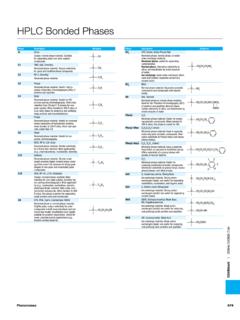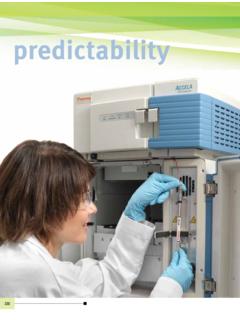Transcription of in The International Pharmacopoeia (July 2012)
1 Working document July 2012 RESTRICTED PROPOSAL FOR REVISION OF high - performance liquid chromatography in The International Pharmacopoeia (July 2012) Draft for comment World Health Organization 2012 All rights reserved. This draft is intended for a restricted audience only, the individuals and organizations having received this draft. The draft may not be reviewed, abstracted, quoted, reproduced, transmitted, distributed, translated or adapted, in part or in whole, in any form or by any means outside these individuals and organizations (including the organizations' concerned staff and member organizations) without the permission of the World Health Organization.
2 The draft should not be displayed on any web site. Please send any request for permission to: Dr Sabine Kopp, Medicines Quality Assurance Programme, Quality Assurance and Safety: Medicines, Department of Essential Medicines and Health Products, World Health Organization, CH-1211 Geneva 27, Switzerland. Fax: (41-22) 791 4730; e-mail: The designations employed and the presentation of the material in this draft do not imply the expression of any opinion whatsoever on the part of the World Health Organization concerning the legal status of any country, territory, city or area or of its authorities, or concerning the delimitation of its frontiers or boundaries.
3 Dotted lines on maps represent approximate border lines for which there may not yet be full agreement. The mention of specific companies or of certain manufacturers products does not imply that they are endorsed or recommended by the World Health Organization in preference to others of a similar nature that are not mentioned. Errors and omissions excepted, the names of proprietary products are distinguished by initial capital letters. All reasonable precautions have been taken by the World Health Organization to verify the information contained in this draft. However, the printed material is being distributed without warranty of any kind, either expressed or implied.
4 The responsibility for the interpretation and use of the material lies with the reader. In no event shall the World Health Organization be liable for damages arising from its use. This draft does not necessarily represent the decisions or the stated policy of the World Health Organization. Should you have any comments on the attached revision, please send these to Dr Herbert Schmidt, Medicines Quality Assurance Programme, Quality Assurance and Safety: Medicines, World Health Organization, 1211 Geneva 27, Switzerland; fax: (+41 22) 791 4730 or e-mail: (with a copy to by 7 September 2012.)
5 We will now send out our working documents electronically and they will also be placed on the Medicines web site for comment. If you do not already receive our documents please let us have your e-mail address (to and we will add it to our electronic mailing list. Working document page 2 SCHEDULE FOR THE ADOPTION PROCESS OF DOCUMENT PROPOSAL FOR REVISION OF high - performance liquid chromatography in The International Pharmacopoeia Date Discussion of preliminary draft revision at consultation on specifications for medicines and quality control laboratory issues 29-31 May 2012 Draft sent out for comments following discussion at consultation on specifications for medicines and quality control laboratory issues July 2012 Collation of comments received August-September 2012 Discussion at forty-seventh meeting of the WHO Expert Committee)
6 On Specifications for Pharmaceutical Preparations 9-12 October 2012 Further follow-up action as required Working document page 3 PROPOSAL FOR REVISION OF high - performance liquid chromatography in The International Pharmacopoeia (July 2012) [Note from the secretariat. It is proposed to revise the chapter on high - performance liquid chromatography to include inter alia a description of the dwell volume and the peak-to-valley ratio.] high - performance liquid chromatography [Note from the Secretariat. Changes from the current monograph are indicated in the text by insert or delete.] Introduction high - performance liquid chromatography (HPLC) is a separation technique that can be used for the analysis of organic molecules and ions.
7 HPLC is based on mechanisms of adsorption, partition, ion exchange or size exclusion, depending on the type of stationary phase used. HPLC involves a solid stationary phase, normally packed inside a stainless-steel column, and a liquid mobile phase. Separation of the components of a solution results from the difference in the relative distribution ratios of the solutes between the two phases. HPLC can be used to assess the purity and/or determine the content of many pharmaceutical substances. It can also be used to determine enantiomeric composition, using suitably modified mobile phases or chiral stationary phases.
8 Individual separation mechanisms of adsorption, partition, ion exchange and size exclusion rarely occur in isolation, since several principles act to a certain degree simultaneously. Apparatus The apparatus consists of a pumping system, an injector, a chromatographic column, stationary and mobile phases, connecting tubing and fittings, a detector, and a data collection device (computer, integrator or recorder). Pumping system HPLC pumping systems are required to deliver metered amounts of mobile phase at a constant flow rate. Pumping systems that deliver solvent from one or more reservoirs are available.
9 Pressure fluctuations should be minimized, by passing the pressurized solvent Working document page 4 through a pulse-dampening device. Tubing and connections should be capable of withstanding the pressures developed by the pumping system. Many HPLC pumps are fitted with a facility for "bleeding" the system of entrapped air bubbles. Modern computer- or microprocessor-controlled pumping systems are capable of accurately delivering a mobile phase of either constant (isocratic elution) or varying (gradient elution) composition, according to a defined programme. In the case of gradient elution, solvent mixing can be achieved on either the low or high -pressure side of the pump(s).
10 Depending on the flow rate and composition of the mobile phase, operating pressures of up to 42000 kPa (6000 psi) can be generated during routine analysis. Injector The sample solution is usually introduced into the flowing mobile phase at or near the head of the column using an injection system based on an injection valve design which can operate at high pressure. Such an injection system has a fixed-loop or a variable volume device which can be operated manually or by an auto-sampler. Partial filling of loops may lead to poorer injection volume precision. Chromatographic column Columns are usually made of polished stainless steel, are between 50 and 300 mm long, and have an internal diameter of between 2 and 5 mm.













